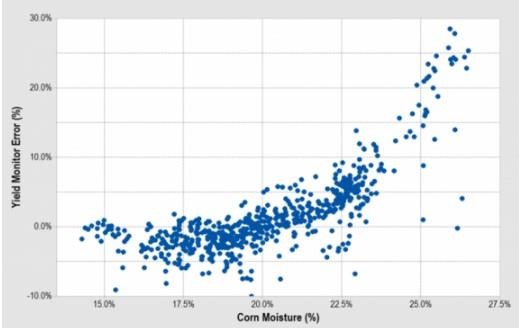A typical calibration process requires three steps:
- Harvest a calibration load.
- For multi-point calibrations these loads should be between 3,000 to 6,000 lbs.
- For single-point calibrations these loads can be larger, up to a full grain tank.
- Weigh the calibration load on a grain cart or truck to get a ground truth weight for the load.
- Enter the ground truth weight into the yield monitor display
This process is repeated for multi-point calibrations using different crop flow rates.
Is Your Scale Accurate?
No matter the make and model of your yield monitor, a scale system is needed to get a “ground truth” load weight. There are many ways to accomplish this, including using seed buggies with scales, grain carts with scales or truckload scale tickets from an elevator. When collecting ground truth load weights for your yield monitor calibration it is important to verify that the scale system you are using is accurate, or you could be introducing more error into your yield data.
Grain Cart Scale Tip: Most growers verify their grain cart scales against truck load net weights from elevator scale tickets. This is a good practice and an easy way to ensure your grain cart scales are still accurate throughout the season. However, when using your grain cart to calibrate your yield monitor, consider leaving the grain cart half full when collecting ground truth weights. This will ensure the weight range on the grain cart scales is closer to the full cart weight values that you have been verifying against elevator tickets.
Why A Calibration Process Matters
Most yield monitor systems used today have the ability to utilize a multipoint calibration process. This is typically more accurate than using a single point calibration process. The multipoint calibration will better capture and quantify the variability across a field.
Yield monitors calculate yield based on fluctuations in mass flow rate. The yield of any crop will naturally fluctuate throughout a field due to a host of agronomic factors. This means that even if you drive at a constant speed with the combine, the actual flow rate or through-put of the combine will fluctuate as the yield changes. It’s important to have calibration points for these different flow rate ranges to ensure the yield monitor is accurately calculating yield.
Changes in flow rate can be simulated for calibration purposes by driving at different ground speeds through an area of the field with consistent yield. It’s important to drive a consistent ground speed for the entire calibration load. Collect several calibration loads at your normal operating speed (for example, 4 mph), then, capture calibration loads at slower and faster ground speeds (for example 2, 3, and 5 mph). This process will fluctuate the flow rate through the combine and ensure that you have multiple points throughout the calibration curve.
Failing to calibrate at multiple flow rates will result in less accurate field totals and spatial distribution of yield on a yield map.
Recalibrate when Crop Moisture Changes
Recalibrating your yield monitor throughout the harvest season when crop conditions change is critical to maintaining yield map accuracy. Changes in grain moisture can affect the accuracy of the calibration, and as your crop continues to dry down later in the season the yield monitor’s sensor will react differently. Yield monitors in corn are particularly sensitive to moisture changes. Corn that is harvested above 20% moisture will require recalibration every 2.5% change in moisture to maintain yield monitor error of less than 5% (Figure 1).

Figure 1: Corn moisture influence on yield monitor error.
As the season progresses, pay close attention to the mechanical components of the grain handling and yield monitor system. Inspect the sensor periodically for dirt buildup or other debris obstructing it. Regularly check for proper tension on the combine’s clean grain elevator chain, as this is critical in maintaining consistent yield monitor accuracy. If you re-tension the clean grain elevator chain it is recommended that a new yield monitor calibration be performed.
Yield monitors are an incredibly valuable tool for farmers if properly calibrated and maintained throughout the harvest season. While the initial calibration process and confirmations through the season require time, farmers will reap the rewards of careful planning with high quality yield data.
Source : iastate.edu